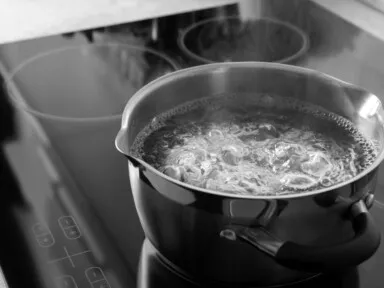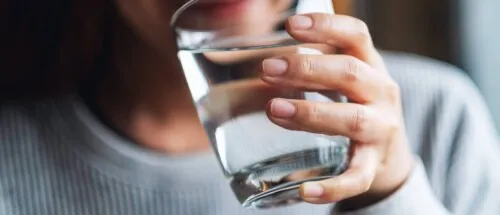Technically, yes—boiling water can neutralize most disease-causing organisms, including pathogenic bacteria, viruses and protozoa, according to the EPA. However, it won’t do much against certain contaminants (like heavy metals) that can cause lasting damage. There are plenty of other ways to purify your next glass of water.
In this article:
Understanding Water Purification
Before any sides are taken when it comes to boiling tap water, it’s important to understand how water purification works.
Purification has different definitions depending on how the item or liquid is going to be consumed. Water purification, in a scientific sense, ensures the removal of all or most chemical or biological contaminants. This includes pathogens that may have invaded the water supply (e.g., bacteria or viruses) as well as pollutants and toxic metals.
Other water purification methods, like deionization, cover the removal of minerals from water as well. Other definitions may just cover the removal of basal contaminants (like parasites and fungi) without the full removal of plastics, toxins, or chemicals that may be present, despite a rolling boil.
The Boiling Method
The safety of boiling tap water comes down to the boiling method that’s used. Ideally, you should consider other types of water treatment, but if they aren’t available or if it’s an emergency situation, the boiling method can produce drinkable, semi-safe water by killing bacteria and other microorganisms that can cause illness, like giardia. It won’t remove plastics or chemicals, however, so it’s best used in a controlled situation when other options aren’t available.
Practical Guidelines for Boiling Water
If you’re in a situation where there’s no other water supply available, you may find that boiling water is the safest way for you to make water safer to consume. The U.S. Centers for Disease Control provides guidelines to help you neutralize waterborne diseases in your boiling process, giving you the highest emergency water quality possible:
Step-by-Step Boiling Process
- Prepare your water. If your water is cloudy, consider running it through a coffee filter to remove visible contaminants that could be worsening the quality.
- Heat your stove and grab a pot. Once you have the heat going, pour the water into a pot and bring it to a rolling boil for at least 1 minute. If you’re at an elevation higher than 6,500 feet, boil your water for at least 3 minutes.
- Cool it off. Allow your water to cool fully before storing it.
- Take a sip. If you don’t like the taste, consider adding a pinch of salt per quart or liter of prepared, boiled water.
Situations Where Boiling is Recommended
There are plenty of situations when you might have to boil your water, including during:
- Natural disasters
- Water line or system disturbances (such as pressure loss or breakages)
- Boil water advisories
Boiling water, while necessary at times, isn’t the most energy-efficient way to purify your drink. If you find yourself in a situation where you have to boil water frequently to make it drinkable, you may benefit from a more sustainable system.
Common Misconceptions
There’s a lot more to water boiling than meets the eye. Here are a few of the common myths (and busts) around the practice, and what you need to know to keep your health intact.
Boiling vs. Complete Purification
Boiled water is not the same as water that’s been run through a water filter for complete purification. While boiling water reduces most bacteria, protozoa, and Cryptosporidium, it may still have remnants of pesticides or inorganic contaminants that can cause harm. It’s best to run this processed water through a filtration system when possible for complete purification—this will give you the safest drinking water.
Safety of Boiled Tap Water
Boiled tap water can typically be used in situations where you’d use normal, bottled water—such as:
- Washing dishes
- Brushing your teeth
- Washing or preparing food
- Ice
- Baby formula or toddler foods
- Handwashing, showering, and cleaning
- Drinking (if necessary)
Comparing Boiling with Other Purification Methods
Is boiling your best bet when it comes to keeping clean water in your home? Not usually. There are plenty of other alternatives that are more ideal in terms of cost, effectiveness, and practicality.
Filtration Systems
Water filtration systems can be house-wide, providing you access to clean water that’s free of most impurities whenever you run your faucet. These also usually result in softer water, which can reduce wear and tear on your pipes.
Chemical Disinfection
Chemical disinfection is extremely effective against most organic pathogens. However, it’s not recommended for home or regular use. Beyond the high price tag for most residential homeowners, this method is dangerous if misused, as chemical overdoses can occur. It can also leave behind a chemical smell and taste that’s hard to get around. This type of system is typically reserved for reservoirs and public filtration plants, where it can be highly regulated and used effectively.
UV Treatment
UV filtration is one of the most effective methods for killing pathogens and viruses from water. The UV light neutralizes and sterilizes viruses, bacteria and microorganisms. UV filtration is typically an add-on to an existing whole-home water system.
Boiling Water: One Method for Purification
Water boiling may neutralize most bacteria, viruses, and pathogens. Bringing your water to a full, rolling boil for at least three minutes will give you the preliminary, safely prepared product for cleaning or regular household use.
However, just because water is boiled, doesn’t make it safe. Instead, you should consider running the boiled water through an additional filtration process to catch additional contaminants that could cause long-term harm.



